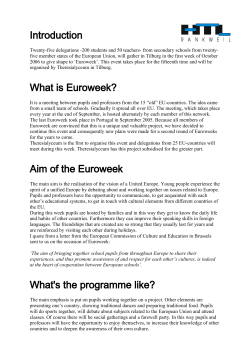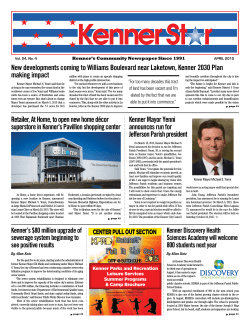
Dr Clare Kelly Goldsmiths, University of London
Dr Clare Kelly Goldsmiths, University of London ‘What happens with children outside the school is very separate from us, we don’t really get to see that other part of the child, and having worked particularly with the older children they often don’t like to really talk to you about it… I think they see that side of their life as much more part of their family and community, and the school – sadly, I don’t know if they feel that as much.’ Kenner & Ruby, 2012 p xi Responding to pupils’ needs and overcoming potential barriers for individuals and groups of pupils ‘4.5 Teachers must also take account of the needs of pupils whose first language is not English. Monitoring of progress should take account of the pupil’s age, length of time in this country, previous educational experience and ability in other languages. 4.6 The ability of pupils for whom English is an additional language to take part in the national curriculum may be in advance of their communication skills in English. Teachers should plan teaching opportunities to help pupils develop their English and should aim to provide the support pupils need to take part in all subjects.’ DfE 2013, p.8 Communication with the whole family and the community Extending the enjoyment of reading and writing Access to two cultures Tolerance of other languages and cultures Thinking benefits -Creative thinking , Sensitivity to Communication , IQTests, A head start in reading Raised self-esteem Security in identity Educational benefits Easier to learn a third language Employment advantages http://www.assemblywales.org/paper_3_-_prof._colin_baker.pdf In the London Borough of Lewisham ‘32.8% ( 5,718) of children speak a language other than English as their first language.’ https://www.gov.uk/government/publications/schools-pupils-and-theircharacteristics-january-2012. Accessed 16.10.13 ‘ London has the largest number of community languages spoken in Europe. Over 300 languages are spoken in London schools.’ http://www.londoncouncils.gov.uk/londonfacts/default.htm? category=2 accessed 16.10.13 More than 60 languages are taught to children at complementary schools usually run by the communities themselves with classes held after school or at weekends. http://www.naldic.org.uk/research-and-information/eal-researchtopics/bilingualism. Accessed 16.10.13 ‘Complementary schools are multilingual and multiliterate sites which provide a safe space outside mainstream school for maintenance and transformation of young people’s community languages and cultures.’ Creese & Martin, 2006 p.xiii ‘Although the course focuses on ethnic and linguistic diversity, we guard against viewing it as having two separate parts. The issues raised by both tutors will often apply to the same children and the course is planned to focus on the interrelationship between diversity, inclusion, equality and social justice.’ ‘This course will tackle complex and controversial issues, and students should come willing to speak openly and learn from each others’ experiences. The aim is that the course will be both personally challenging and stimulating, and that it will have a real impact on your developing ideas about what it means to be a good teacher.’ Excerpts from the introduction to the course in the module handbook. What are student teachers’ perceptions of linguistic minority pupils’ learning after the visit? How can tutors build on that knowledge to support students’ teaching of pupils from diverse backgrounds? Do bi/multilingual student teachers understand how they can use their own bilingualism in their teaching? Based on Robertson, 2010 Sociocultural theory of learning: knowledge is co-constructed and learning occurs through social interactions in informal as well as formal settings. Vygotsky, 1962; Cole, 1996; Rogoff, 2003, Gregory, Long & Volk, 2004. Significance of complementary schools for identity development supported through the interaction of language and culture and impact on academic achievement. (Creese & Blackledge, 2010; Lytra & Martin,2010; Issa & Williams, 2009; Martin et al, 2007; Li Wei, 2006; Creese et al, 2006.) Mainstream teachers’ lack of knowledge of bilingual children’s experience outside of school. (Blackledge & Creese, 2010; Cummins, 2010; Hancock, 2009; Conteh et al, 2007; Blackledge, 2006; Kenner, 2004; Gregory et al, 2004.) Benefits of collaboration between teachers in complementary and mainstream schools. (Kenner & Ruby, 2012; Kenner et al, 2008; Conteh & Begum, 2008) Benefits to students on an ITE course of visiting complementary schools and reflecting on implications for their teaching . (Robertson, 2010) Individual semi structured interviews with with four student teachers Semi-structured interviews and email correspondence with headteachers Audi-recordings and transcriptions of whole group feedback in college after the visits Informal discussions with children Observation in school during students’ visits Approximately 25 PGCE students each year over three years Visits were optional and took place at weekends or after 4pm in schools across London. Students were asked to prepare for the visit by reading Kenner & Ruby (2012), ‘Co- constructing bilingual learning: an equal exchange of strategies between complementary and mainstream teachers’. Tamil Arabic Mandarin Albanian Russian Bengali Students observed teaching They spoke to children, staff, the headteacher parents (where possible) Observe how children use their languages and pay particular attention to different speaking, listening, reading and writing activities. Observe how children use English Analyse how children see themselves as learners in these classrooms Based on Robertson, 2010 ‘Thanks so much to you and your staff for allowing me to come and observe lessons at your school today. I found it very insightful, and it has given me a better understanding of the experiences children have of complementary schools, as well as seeing how switching between language aids learning. I hope to use this experience to better aid me in my own teaching of bilingual children.’ ‘When talking to the girls I learnt that the younger girls liked learning with the older girls because they helped them. This peer learning is fantastic - another great strategy you are using that research has proven to be very beneficial to learning.’ ‘As a potential teacher I have learnt a lot from the visit, how language schools can complement mainstream schools and give children a real sense of pride in their heritage culture.’ I expected it to be more rigid, but children loved being there, there was a social aspect, it was the community they liked.’(Tamil) ‘It was so professional. I thought it might be amateur and disorganised because of funding, using volunteers. The teaching was amazing and they only get their expenses.’ ( ‘I sat down next to a boy, just to make myself comfortable and he turned to me and said “I am the best in this class and I never want to be lazy or unemployed”. The headteacher said later that’s what they want to translate to their other school. I was shocked.’ They don’t talk about what they do in the community school. It’s separate and two girls said they don’t tell the teacher they speak Russian either.’ (Shona) ‘You get a real sense of the community here. One child I spoke to said she liked being with her friends and having people around that understood her. There are families here and a community base. Children feel like they are part of something bigger.’ (Leah) ‘The children were really enthusiastic and enjoyed being there. They felt assured, it was their school.’ (Jasmine). ‘They were dealing with health and legal issues as well and you get a sense of pride in the place and in what they are doing.’ (Tom). ‘They wouldn’t go to break until they had reached 100 points, there were incentives to do well but the motivation came from the children. The teachers were relaxed and let them get on with it.’ (Becky) ‘In the quranic reading class there was recitation as children are encouraged to memorise the Qur’an, so that’s what you’d expect. It was really respectful and the children just carried on with it. They knew what they were doing.’ (Naheedah) ‘They took their responsibilities as learners seriously. Amongst themselves as 8 year olds they were discussing that it’s really good to learn Russian for the future. It was quite odd to hear this coming from such a young person. But they knew having another language was important, it was important for talking to their families in different countries and their friends and they just took the whole learning process very seriously.’ (Nadia) ‘In the younger classes… Arabic is so complicated and they know so much. …..they know it so well and they were constantly comparing what they were doing with each other, “it looks like a backwards C ” coming up with that all the time, comparing it themselves.’(Jade) ‘I keep going back to the year 1 class where the level of discussion surprised me. I could recognise it without knowing the language. Witnessing that level of discussion in Russian made me think I can, I can do that if I am able to encourage the children to bring what they can do into the mainstream school.’ (Nasima) ‘It was all A stars in my school too. The language is about more than the exam, it goes above and beyond the classroom, it’s about their lives and learning their own language and speaking it for real to people around them. It’s the whole person, rather than just the language.’ (Joe). ‘You could tell they were proud of their culture, but the children I spoke to said they didn’t say at their other school that they spoke another language. They were proud of both schools , they loved both schools but they didn’t merge the two.’ (Becky) ‘They were all really motivated and they were all helpful of each other, so when they were doing the dance, there were a couple of young girls who were new to the thing and two of the older girls took them aside and they were explaining in English and in Tamil, fluently, you know just switching between the two quite naturally (Joe). ‘I’m going to get children to talk openly about their schools. I’ll ask them to bring in some writing or something from home to start with.’ (Mary) ‘I want to get children to talk about their experiences at complementary school, maybe bring in their own resources. Even though it was in the past I could still talk to them about what I saw and what I’ve learnt from going to the Chinese Mandarin school. Because my home language is Ibo and we don’t have Ibo schools. I will say I would have liked that to be in place for myself and maybe saying that would help them to talk about it.’ ‘I’d like to make use of my own language because I can speak Cantonese and hopefully if I can communicate my own sense of pride in my language I can encourage the children to speak theirs. I can read a dual language book in Cantonese and find out what languages they speak and then find books in their languages.’ ‘It’s made me think about the importance of having a good relationship with parents, finding out the detail of the languages they speak and the importance of all those languages they bring to the classroom that I can build on.’ ‘ I want to be able to say, I’ve been to your school and I’ve met your teachers, then you’re removing a barrier and sharing experiences. They are more likely to listen to you because they won’t just be doing things like Wilma and Wilf and Floppy, that are completely unrelated to them.’ ‘I’d like to be able to say it’s made a difference, but seeing how difficult it is to fit everything into the day. I wanted to do language of the month and I couldn’t fit it in. I think time is an issue’ All student teachers who came last Sunday were delightful, polite and enthusiastic. …the visit went well. I hope to see more and continue the co-operation between us. ‘We want to the students to keep coming and to talk to the children, to me, the staff and parents. We use different language methodologies. They will find out about our language and culture and we need to have links outside.’ Standard 5 Know when and how to differentiate appropriately, using approaches which enable pupils to be taught effectively; have a secure understanding of how a range of factors can inhibit pupils’ ability to learn, and how best to overcome these; demonstrate an awareness of the physical, social and intellectual development of children, and know how to adapt teaching to support pupils’ education at different stages of development; have a clear understanding of the needs of all pupils, including those with special educational needs; those of high ability; those with English as an additional language (my emphasis); those with disabilities; and be able to use and evaluate distinctive teaching approaches to engage and support them. Blackledge: Starting points, in A. The racialization of language in British political discourse. Critical Discourse Studies. 3 (1) 61-79. Cole, M. (1996) Cultural Psychology. London:Routledge Conteh, J. & Begum, S. (2008) Bilingual teachers as agents of social change: Linking the community and the , mainstream, in Kenner, C. & Hickey, T. (eds) Multilingual Europe. Diversity and Learning. Stoke on Trent: Trentham. Conteh, J. Martin, P. & Robertson, L.H. (2007) Conteh, J.; Martin, P. & Robertson, L.H. (eds) Multilingual learning. Stories from Schools and Communities in Britain. Stoke on Trent: Trentham. Creese, A. Bhatt, A, Bhojani, N. & Martin, P. (2006) Multicultural heritage and learner identities in complementary schools. Language and Education, 20 (1) 22-43. Creese, A. & Blackledge, A. (2006) Translanguaging in the Bilingual Classroom: A pedagogy for learning an teaching? The Modern Language Journal 94 (1) 103-115. Gregory, E., Long, S. & Volk, D. (2004) Syncretic literacy studies: Starting points, in Gregory, E., Long, S. & Volk, D (eds) Many Pathways to Literacy. Young Children learning with siblings, grandparents, peers and communities. London: Routledge Hancock, A . (2009) Synergy or Two Solitudes? Chinese children’s experiences of biliteracy learning in Scotland. Paper presented at Multilingual Europe Seminar. ‘Multiple Spaces, Multiple Languages, Multiple Literacies. University of Issa, T. & Willimas, C. (2009) Realising Potential. Complementary Schools in the UK. Stoke on Trent: Trentham. Kenner, C. & Ruby, M. (2012a) Interconnecting Worlds. Teacher Partnerships for Bilingual Children. Stoke on Trent:Trentham. Kenner, C. & Ruby, M. (2012) Co-constructing bilingual learning: an equal exchange of strategies between complementary and mainstream teachers, Language and Education . 26 (6) 517-535. Martin, P. Bhatt, A, Bhojani, N, Creese, A. (2007) in Conteh, J. Martin, P, & Robertson, L.H. (eds) Multilingual learning. Stories from schools and communities in Britain. Stoke on Trent: Trentham. Robertson, L. (2010) Developing Links between complementary schools and initial teacher training, in Lytra, V. & Martin, P. (eds) Sites of Multiligualism. Stories from schools and communities. Stoke on Trent: Trentham.
© Copyright 2025












